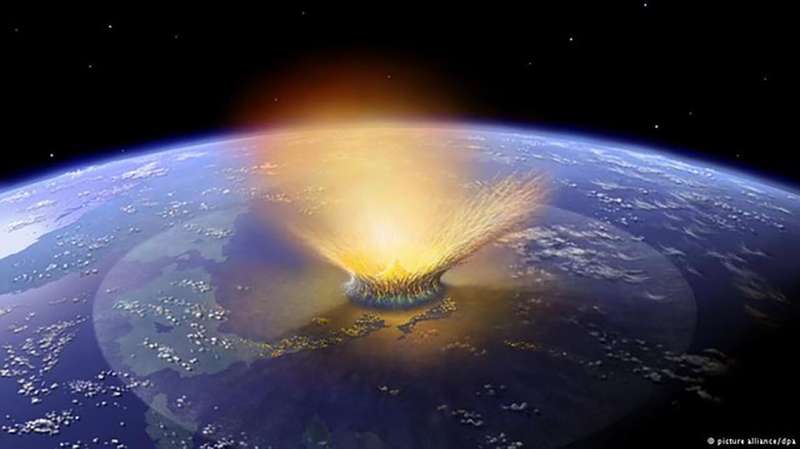A large asteroid (~12 km in diameter) hit Earth 66 million years ago, likely causing the end-Cretaceous mass extinction. Credit: Southwest Research Institute/Don Davis
A team of researchers from the U.S., Australia and the U.K. has found evidence that suggests material thrown into the atmosphere by the asteroid that struck the Earth approximately 66 million years ago, and not massive wildfires, led to a mass extinction event. In their paper published in Proceedings of the National Academy of Sciences, the group describes their study of sediment from the Chicxulub crater and other ocean areas and what it showed them.
Over the past several decades, Earth scientists have come to believe a large asteroid slammed into the Earth just off the coast of what is now Mexico's Yucatán Peninsula approximately 66 million years ago. The impact of the asteroid strike was so great that it led to a mass extinction event that killed off the dinosaurs. Evidence of the asteroid strike has been found around the globe, and so-called K–Pg boundary records have been identified. They are evidence of material in the atmosphere circling the globe after the asteroid strike, blocking out the sun, which resulted in plants and animals dying. But one area of contention has remained: the source of the material in K–Pg boundary records. Prior research has suggested it came from material that was burned by massive wildfires that were set off by the asteroid strike. In this new effort, the researchers suggest that while some of the material in K–Pg boundary records is likely from such burnt material, most of it came from material ejected from the crater at the impact site.
The work involved analyzing sediment samples from within the Chicxulub crater and from other ocean sites near the crater. In their analysis, the researchers focused on polycyclic aromatic hydrocarbons (PAHs), which can provide evidence of a source of black carbon. In so doing, they found that the samples came from a fossil source, not from burned material from wildfires. They also found that the characteristics of the PAHs showed they came about due to rapid heating, which, the researchers note, was consistent with rocky material ejected from an impact crater. The researchers also found small amounts of charcoal in the samples, indicating that some small amount of burned biomass had also made its way into the atmosphere. They conclude that the material in the K–Pg boundary records came mainly from material ejected from the crater and not from wildfires.
More information: Shelby L. Lyons et al. Organic matter from the Chicxulub crater exacerbated the K–Pg impact winter, Proceedings of the National Academy of Sciences (2020). DOI: 10.1073/pnas.2004596117
Journal information: Proceedings of the National Academy of Sciences
© 2020 Science X Network
























